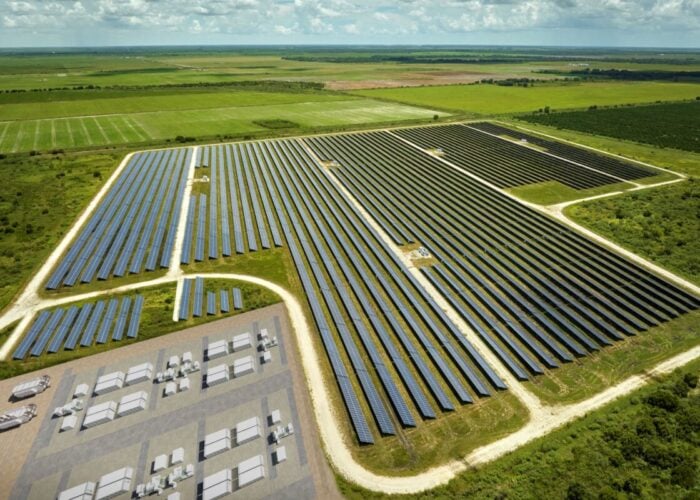
The dollar-per-watt metric has traditionally formed the basis of PV module purchasing. But as Anza CEO Mike Hall argues, this simplistic formula can lead to costly mistakes and stand in the way of getting the best value from procurement decisions.
Over the last five years, we’ve seen a massive transformation in how large-scale solar projects work in the US. When I started in the solar industry over 20 years ago, module and other major material procurement was primarily performed by EPCs and installers. Today, utility-scale and distributed generation owners have almost entirely taken on these responsibilities.
Unlock unlimited access for 12 whole months of distinctive global analysis
Photovoltaics International is now included.
- Regular insight and analysis of the industry’s biggest developments
- In-depth interviews with the industry’s leading figures
- Unlimited digital access to the PV Tech Power journal catalogue
- Unlimited digital access to the Photovoltaics International journal catalogue
- Access to more than 1,000 technical papers
- Discounts on Solar Media’s portfolio of events, in-person and virtual
Coinciding with this transformation is an increasingly dynamic market. Module procurement teams must now navigate US Customs detainment (from UFLPA policy), AD/CVD duties, technology changes, price instability and a massive increase in viable module vendors. In the middle are procurement teams stuck managing these complexities with insufficient data, tools and frameworks for risk reduction, leaving them with limited time to manage other problems with ultra-long lead time components such as switchgear, transformers and specialty breakers. Multi-million-dollar decisions shouldn’t rely on outdated, manual time-consuming processes that saddle resource-constrained procurement teams and lead to suboptimal results.
Throughout this article, we’ll share what we see as some frequently overlooked but winning procurement strategies. In many cases, these recommendations conflict with the industry norms and past practices. At Anza, we’re simply following the data.
Dollar-per-watt thinking reduces project returns
I started my career in solar in 2002, and for the last 22 years (and possibly longer), the industry has used the dollar-per-watt (US$/W) cost of modules to negotiate prices, build financial models and make procurement decisions. At first glance, it makes sense. There are several modules on the market, all with varying nameplate wattage. Power and energy are incredibly important when getting a project off the ground, so this is a simple way to rapidly compare products. The problem is in the vast majority of cases using the US$/W cost of modules will lead you to buy the sub-optimal module for your project.
Taking the module unit cost and dividing by nameplate watts (the US$/W strategy) ignores two critical components of financial value: energy production and installation costs. Every solar module has different performance characteristics, and while these differences are largest between technology families (between Mono PERC and TOPCon cells, for example), they also exist between products of the same technology. Module-expected degradation, thermal performance, and non-incident light absorption are all factors that play a role. These variables are usually determined through third-party testing and represented in a PAN file.
Similarly, modules can also have materially different costs to install. Many factors can drive these differences; for example, generally (but not always) higher watt class modules – large format modules – are less expensive per watt to install because fewer pieces are required. Another factor, such as how the modules string or sit on the tracker, can also impact the balance of system (BOS) costs. So why does this matter? We often see examples of utility-scale solar buyers missing out on millions (or even tens of millions) of dollars in value by using $/W as the primary value metric.
For example, we worked with a client who was in the market for 50MW of modules for a single project. They had been focused on a low-cost Tier 1 Mono PERC product. However, we were able to show them that by paying 1.7 cents per watt more, they could get a more efficient module that generated additional energy worth 3.1 cents per watt and expected BOS savings of another 3 cents per watt. In aggregate, paying 1.7 cents more generated 4.5 cents in value. To put this in perspective, on 50MW, that’s US$2.2 million — enough value to fund most procurement departments for several years. We’ve also seen utility-scale examples where buyers were likely to miss out on as much as US$30 million of value by ignoring these factors.
We saw that the market was missing critical data and analytics to perform these calculations. This is why we created the ‘Effective $/W’ metric. This metric incorporates the installation cost, balance of system impact and production revenue-related impacts into the module comparison. It is calculated by subtracting BOS savings and production benefit from module price. This analysis is something that has historically been completed manually, if comprehensively analysed at all, taking procurement teams weeks or months to compare prices and wasting valuable time and resources due to static pricing models and insufficient data.

Bulk equipment buying can kill your bottom line
In working with utility-scale developers and independent power producers (IPPs) we’ve seen a recurring pattern. Large-scale buyers will package multiple projects (or even multiple years of demand) to get to increase order size. These often result in single orders over 500MW and, on occasion, even multiple gigawatts. The rationale is that economies of scale will drive down prices, generating significant savings. This makes sense in theory, but the problem is the data shows this just doesn’t work in an industry that’s constantly evolving.
A majority of large purchases result in non-optimal outcomes for several reasons. The first has to do with timing. When procurement teams are buying for multiple projects many quarters ahead of time, they have to make educated guesses about when modules will be needed on site. As anyone who has developed projects knows, construction start dates are incredibly difficult to predict a few quarters out (never mind six or more). Interconnection, permitting, M&A activity, and financing issues frequently delay projects. The larger the buy, the more guesses procurement teams have to make and the greater the cost associated with their inevitable misses.
Early module orders and shipments can kill your bottom line. They can tie up capital via early deposits and payments and rapidly pile up storage costs. Following a “just in time inventory” (JIT) strategy has proven to be a winning business strategy — Toyota proved this during the pandemic when companies implementing a “just in case” inventory model ultimately fared worse. Big bulk buys are the enemy of JIT.
For example, one of our clients made a 100MW purchase to cover module supply for two projects. The purchase timing ended up being about two years too early. Just the warehousing costs alone for these modules ended up costing them US$3.75 million. Then, the question still remains whether these are the optimal modules for their project, as the cell technology and module costs have changed significantly in this period. Besides this example, we’ve arranged warehousing storage that has cost other customers of ours US$1.8 million in 2023.
The second issue is that once you pass around 150MW, there is no clear correlation between order size and price. At Anza, we work with over 70 large-scale developers and IPPs. At any given time, we’re helping subscribers on multiple utility-scale procurements. We have more data on real price quotes than anyone else in the industry. The graph below shows a chart of our recent price quote data. You’ll see that smaller distributed generation scale buyers pay a higher price than large utility-scale buyers. However, once you cross the 100MW line the correlation is weak. At that volume, other factors have a greater impact on the price than scale.

The final reason it doesn’t make sense to do multi-project bulk buys is that the optimal module for one project may not be the best for all your projects. As mentioned above, price is only part of the financial equation when choosing a module. Energy production and BOS costs can be just as – or more – important. The problem is these factors are project specific. For example, if Project A has a PPA that’s 10% higher than Project B, additional production is worth 10% more. Differences in weather can also drive changes in Effective $/Watt. At the utility scale, it makes sense to buy the best module for every project, and for that reason, we strongly recommend that utility-scale IPPs and developers procure one project at a time.
Savvy contract negotiation is crucial
I’ve been part of more M&A (both successful and unsuccessful) processes and worked with more investment bankers than I’d like to admit. One of the most glaring differences between the successful and unsuccessful processes I’ve participated in is how much of the term negotiation takes place before exclusivity. Eight-figure solar module purchases are no different. We often see large awards being made with only the most basic terms having been decided. Buyers and sellers will move forward with a simple price, product and delivery schedule agreement. Sometimes, even critical items like payment terms are left for later.
At Anza, we have consistently found that doing this wastes time, costs more and reduces the buyers’ leverage in the negotiation process. There are critical risks and financial terms embedded in supply contracts that can be negotiated before issuing an award. These include issues around warranty, supply chain risk (e.g. UFLPA, AD/CVD, etc.), liquidated damages, QA/QC standards and serial defect clauses. Taking these terms as a whole could be financially impactful, often representing more value than the delta between shortlisted bidders.
The challenge for buyers is often limited bandwidth and access to data. With forty Tier 1 module makers and an incredibly dynamic market, it’s very difficult to know what the market terms are today. Furthermore, negotiating contracts pre-award with ten or more suppliers is impractical for most procurement teams. Even with those challenges it can be done, but structure and data are the key.
That’s why it is helpful for buyers to have a solution like what Anza provides. We have executable supply contracts with over 30 suppliers representing approximately 95% of the US module supply. We’ve taken the key terms from those contracts and put them into a structured database that developers and IPPs can use to compare, contrast and filter vendors. This enables our subscribers to focus each vendor on what they need to do contractually to compete and win before an award.
Spend more time planning and less time doing
Another Toyota business practice that was introduced to me a decade ago is the Lean Management Foundation (also from the Toyota Production System), and it has changed everything about how I look at business, operations and management. One of the most useful tools in Lean is the Plan Do Check Act (PDCA) cycle for continuous improvement. PDCA is a process based on the scientific method, arguing that if you spend more time upfront understanding the problem you are trying to solve, you’ll get to a better solution faster than blindly moving forward. The same concept applies to solar module procurement.
Our experience has taught us that spending extra time to understand all of a project’s requirements, showstoppers and preferences upfront can lead to faster and better execution. At Anza, we have a 75 point discovery process that we take every client through. To complete it, we need input from many different parts of an organisation, including procurement, engineering, development, legal and finance. When going through this process, we often find that procurement teams are given incomplete information from other parts of the organisation, which can impact decision making. It’s hard work, but we recommend fleshing every detail out before going to the market for bids. Not doing so leads to lots of rework and wasted time for buyers and sellers.
As the industry moves at hyperspeed to get new solar projects online, there continue to be countless hours lost, project setbacks, and subpar product choices due to inefficient approaches to module procurement. While module prices have come down, they still comprise a significant share of the overall project cost and are a massive source of risk. If the modules don’t produce as expected or the vendor doesn’t deliver high-quality products on time, the project will suffer. Even more significant is the millions in untapped value that are forfeited, along with increased long-term capital requirements that ultimately dent profitability.
Our experience and data have shown us that many of the industries’ past procurement practices aren’t working. Large-scale developers and IPPs are unnecessarily tying up their balance sheets and missing out on better deals. We have seen that there is a better way. Broad adoption of renewable energy hinges on developers, IPPs and EPCs being able to make optimal project procurement decisions. It requires data, technology, process and collaboration.
Mike Hall serves as Anza’s CEO. He began his renewable energy career in 2002 when he co-founded Borrego with his brother, Aaron, and Chris Anderson. In 2021, Mike co-founded Anza in order to help IPPs and developers save time and increase profits by improving access to supply chain data and analytics. Today, Mike’s focus is building Anza’s platform to help the entire industry achieve superior project outcomes. He holds an M.S. in chemical engineering from Stanford University and a B.S. in chemical engineering from the University of California Santa Barbara.







